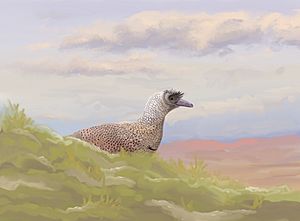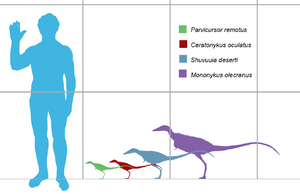Parvicursor facts for kids
Quick facts for kids Parvicursor |
|
|---|---|
 |
|
| Scientific classification | |
| Genus: |
Parvicursor
|
| Species: |
remotus
|
Parvicursor (say "Par-vee-CUR-sor") means "small runner." It was a tiny dinosaur that lived a long, long time ago. This amazing creature had long, skinny legs. This helped it run very fast! It was one of the smallest non-flying dinosaurs ever found. An adult Parvicursor was only about 39 centimeters (15 inches) long. That's about the size of a small house cat! It weighed only about 162 grams (5.7 ounces).
Contents
Meet Parvicursor: The Tiny Runner Dinosaur
Parvicursor belonged to a group of dinosaurs called maniraptorans. This group includes birds and their closest dinosaur relatives. Parvicursor was known for its incredible speed. Its name, "cursor," actually means "runner."
What Made Parvicursor Special?
Like other dinosaurs in its family, Alvarezsauridae, Parvicursor had very short and strong front limbs. Its hands were quite unusual. They had mostly shrunk down to just one large claw. Scientists think this big claw might have been useful for digging. It could have helped Parvicursor open tough termite mounds. This would have allowed it to find tasty insects to eat.
It's unlikely this claw was used for fighting. It was short and not very flexible. Instead, its main purpose was probably for digging or tearing apart things like logs or nests.
Where Did Parvicursor Live?
Parvicursor lived during the Campanian age. This was part of the Late Cretaceous period. It lived about 72 million years ago. Its fossils have been found in a place called the Barun Goyot Formation. This area is in Khulsan, Mongolia.
The first and only known specimen of Parvicursor is incomplete. It mostly includes parts of its pelvis (hip bones) and hind legs. This is why scientists know so much about its running ability!
Parvicursor's Family Tree
Parvicursor had some close relatives. These include dinosaurs named Shuvuuia and Mononykus. All these dinosaurs belong to the same family, Alvarezsauridae. They are also grouped into a smaller family branch called Parvicursorinae. This means they share many similar features.
Are There Other Parvicursor Species?
Scientists are always discovering new things! There might be a second type of Parvicursor that hasn't been officially named yet. In 2002, some tiny alvarezsaurid fossils were found. At first, some thought they were young Shuvuuia dinosaurs. Shuvuuia lived in the same area.
However, in 2009, a study by Nick Longrich and Phil Currie looked closer. They found that these tiny fossils had bones that were fused together. This usually means the animal was an adult, not a juvenile. Their research suggested these were adults of a very small alvarezsaurid species. They seemed to be closely related to Parvicursor. So, for now, scientists call them Parvicursor sp. This means "a species of Parvicursor" that needs more study.
See also
 In Spanish: Parvicursor remotus para niños
In Spanish: Parvicursor remotus para niños


